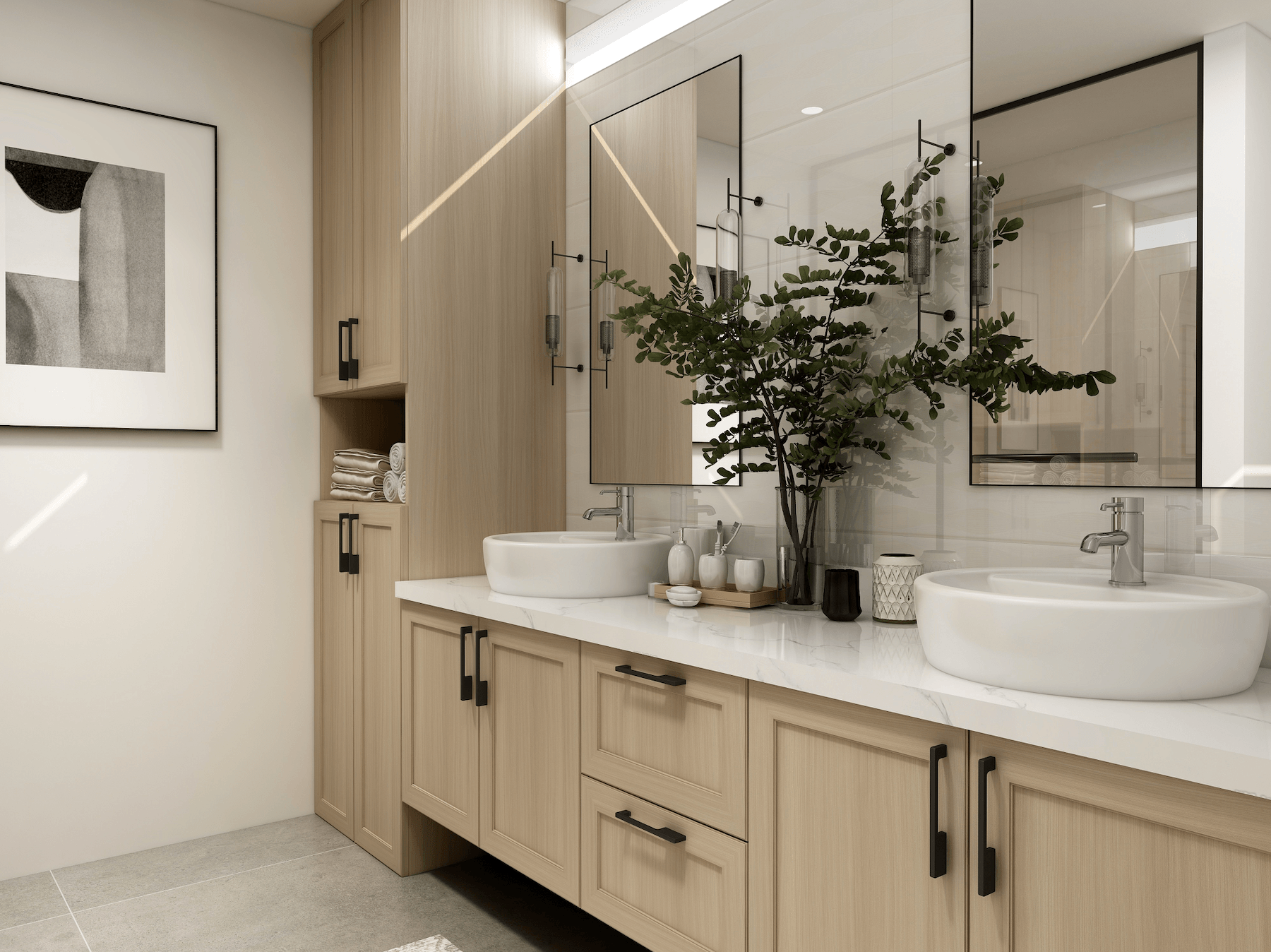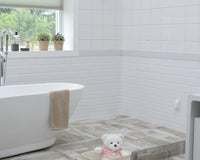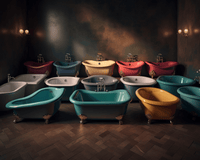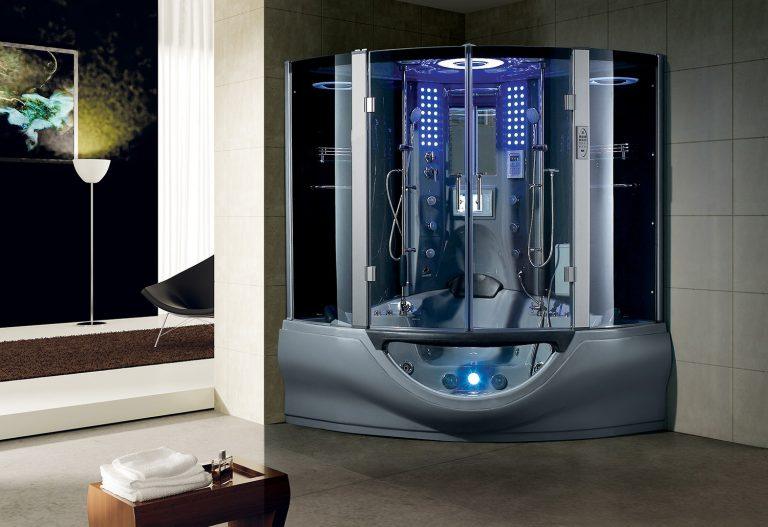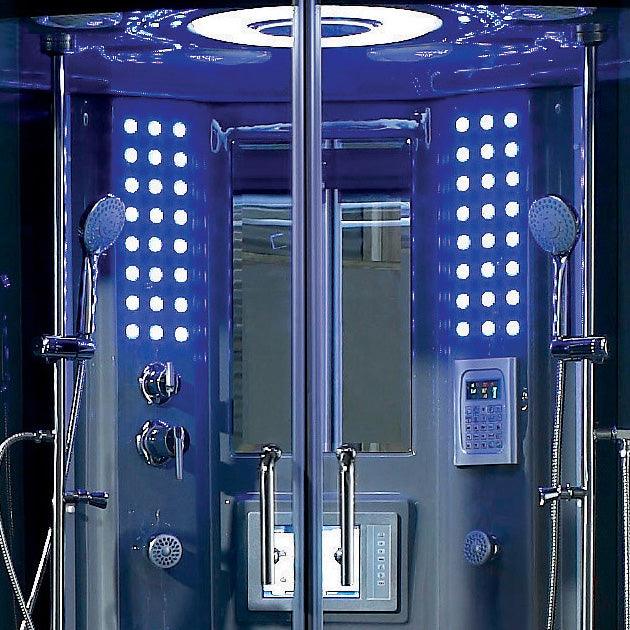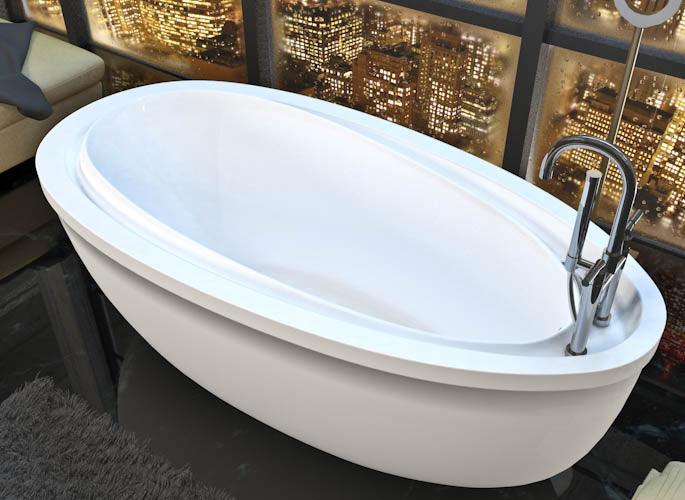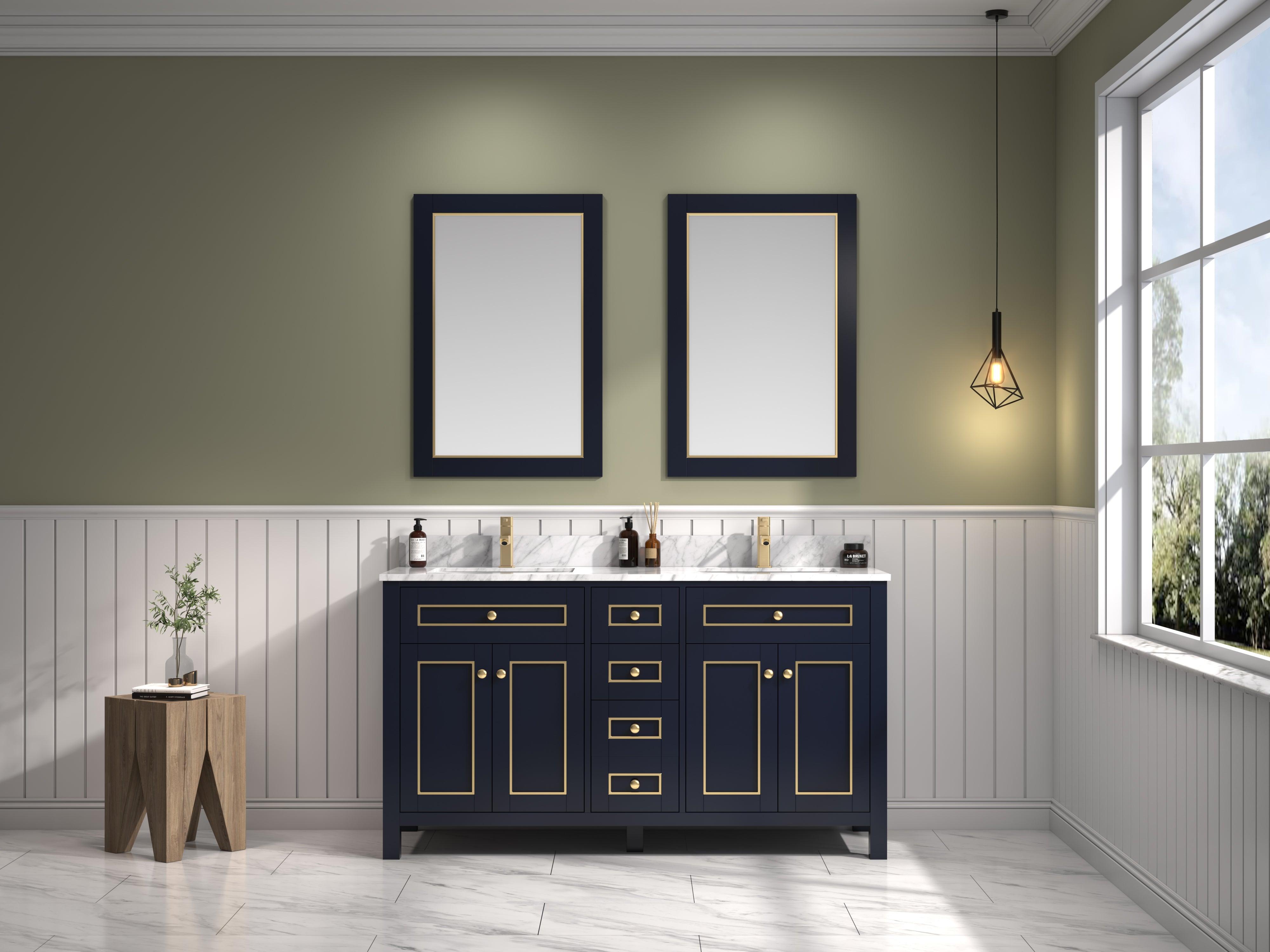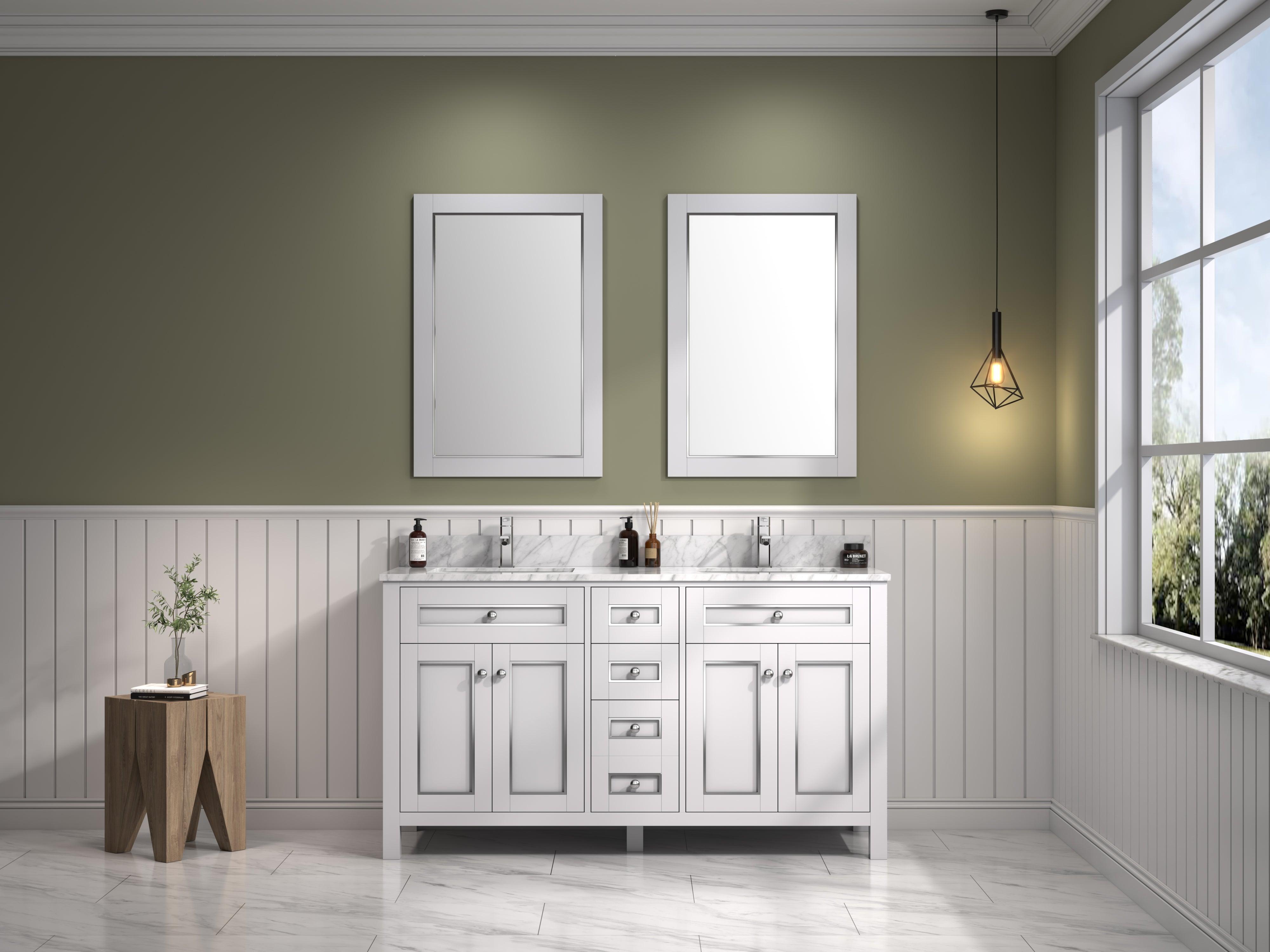Choosing the right vanity for your bathroom can be a daunting task. With so many options available, it's easy to get overwhelmed and make the wrong decision. But fear not, with these five tips, you'll be able to confidently select a vanity that suits both your style and practical needs.
Assess Your Bathroom's Size
Your bathroom is not just a functional space but also an extension of your personal style. Whether you have a luxurious spa or a cramped powder room, choosing the right vanity can make all the difference in maximizing space and creating a cohesive look.
Before you start browsing for vanities, it's important to assess your bathroom's size.
For small bathrooms, finding solutions that maximize space is key. Opting for a wall-mounted vanity or pedestal sink frees up floor space, making the area appear larger than it actually is. If you're set on having a cabinet-style vanity, consider one with slim drawers or open shelving instead of bulky cabinets. This allows for more storage without taking up too much valuable real estate.
On the other hand, if you have ample square footage to work with, don't be afraid to go big! A double-sink vanity adds functionality while giving your bathroom a grander feel. However, keep in mind that bigger doesn't always mean better – choose something proportional to the room so as not to overwhelm the space.
By understanding how much breathing room you have available, selecting the perfect vanity becomes less daunting and more exciting!
Determine Your Storage Needs
First, measure the space you have available for your vanity. This'll help you determine the size and type of vanity you need.
Next, assess your storage needs; how many items do you want to store in the vanity? Think about the items you use in the bathroom on a daily basis.
Lastly, consider the overall design of the vanity; it should match the style of the rest of the bathroom.
With this in mind, you're sure to find the perfect vanity for your space!
Measure The Space
Before you start shopping for a new vanity, it's important to measure your bathroom space. A common mistake is purchasing a vanity that doesn't fit in the designated area or interferes with other fixtures. To avoid this issue, take accurate measurements of the width and depth of the available space. Also, consider the height of the vanity and ensure it won't block any outlets or light switches.
Once you have determined the available space for your vanity layout, think about how you can maximize every inch of it. For example, if you have limited floor space, choose a wall-mounted or corner vanity to open up more room. You can also opt for a narrow depth vanity to free up additional floor space without sacrificing storage capacity. Don't forget to leave ample clearance around the vanity so that there is enough room to access drawers and cabinets comfortably.
Choosing the right size and style of vanity is crucial when designing an efficient bathroom. Measuring your space beforehand will help prevent costly mistakes and allow you to make informed decisions on which type of vanity will work best for your needs. Remember, maximizing your available space should be at the forefront of your mind when picking out vanities!
Assess Storage Needs
Now that you have determined the appropriate size and style of vanity for your bathroom, it's time to assess your storage needs.
One important factor to consider is maximizing space by utilizing every inch available in the vanity layout. This means choosing a design that offers ample storage solutions without taking up too much floor space.
To achieve this goal, start by assessing what items need to be stored in the bathroom. Do you need room for towels, cleaning supplies, toiletries, or makeup?
Once you have identified your specific storage needs, look for organization solutions that fit within the dimensions of your chosen vanity. Consider options like pull-out drawers, shelving units with baskets or bins, and built-in dividers designed to keep everything neat and orderly.
Maximizing storage doesn't just mean having enough room for all of your essentials; it also involves keeping them organized and easy to access. Look for vanities with features such as adjustable shelves or modular components that can be customized to fit your unique requirements.
By carefully assessing your storage needs and selecting a vanity with thoughtful organizational solutions, you'll create an efficient bathroom space that maximizes every inch of available space!
Consider Your Style Preferences
When it comes to choosing the right vanity for your bathroom, one of the most important considerations is your personal style preferences. Your vanity should match the overall aesthetic of your bathroom and reflect your individual taste.
Fortunately, there are countless design options available to suit any style preference. Color options are a key factor in determining the overall look and feel of your bathroom vanity. From classic white to bold black or even vibrant shades like red or blue, there are endless color choices to consider. The color you choose will depend on both your personal taste as well as the existing color scheme of your bathroom.
In addition to color options, there are many design elements to take into account when selecting a vanity for your bathroom. Do you prefer a modern minimalist look with clean lines? Or do you lean towards more ornate detailing and traditional styling? Whatever your preference may be, make sure that it complements other design features in your space such as lighting fixtures, tile patterns, and accessories.
Choose The Right Material
When it comes to selecting the perfect vanity for your bathroom, material is a critical factor to consider. Different materials come with varying degrees of maintenance requirements and durability standards that you must take into account when making your selection.
Here are three popular options:
-
Solid Wood: This choice adds warmth and elegance to any bathroom style due to its natural beauty. However, solid wood requires regular upkeep, including polishing and refinishing.
-
Engineered Wood: If you're looking for a more budget-friendly option than solid wood, engineered wood may be your ideal pick. It's durable, easy to clean and maintain compared to solid wood.
-
Stone or Marble: Natural stone or marble offers stunning aesthetics that can elevate your bathroom design instantly. These materials require professional installation and sealing since they're porous; however, if maintained well, they can last several decades.
Maintenance requirements play an essential role in deciding which type of material suits your needs best. Additionally, think about the overall durability standards against wear-and-tear over time before choosing between these different types of vanities.
As a bathroom design expert, I recommend taking some time evaluating each option's pros and cons before settling on one specific type of material for your vanity. While determining the right fit might seem daunting at first glance, considering factors such as maintenance requirements will help make the process smoother.
Now that we've covered how important it is to select the appropriate material let's move on to discussing another crucial aspect - deciding on a sink type!
Decide On A Sink Type
When it comes to choosing the right sink for your bathroom vanity, there are a few key factors to consider. One of the first decisions you'll need to make is whether you want a wall-mounted or freestanding sink.
Wall-mounted sinks save space and can give an elegant, streamlined look to your bathroom, but they do require more planning upfront as they will need to be installed into the wall structure.
On the other hand, freestanding sinks offer greater flexibility in terms of placement and installation, but they may take up more floor space than their wall-mounted counterparts. Ultimately, the decision between these two types of sinks will come down to personal preference and the layout constraints of your particular bathroom.
Another important decision when selecting a bathroom sink is whether you want a single or double basin.
Double basins add convenience if multiple people share the same bathroom at once, while single basins typically provide more counter space around them. It's worth noting that larger vanities may have enough room for dual basins without compromising on countertop real estate.
Consider how much storage and counter space you need before making this choice.
As with any aspect of bathroom design, choosing the right sink type requires careful consideration of both form and function.
By weighing the pros and cons of each option based on your specific needs and preferences, you can ensure that your new vanity has not only great style but also optimal practicality.
Factor in plumbing requirements next to complete your journey towards creating a well-designed and functional bathroom oasis!
Factor In Plumbing Requirements
When choosing the right vanity for your bathroom, plumbing accessibility is key.
Make sure you have room to access the plumbing lines and valves.
Additionally, consider the drain location; is it center-set, right-hand, or left-hand?
These details will help you decide on the best vanity for you.
Plumbing Accessibility
When it comes to choosing the right vanity for your bathroom, one crucial factor you should consider is plumbing accessibility.
You want a vanity that allows easy access to pipes and drain lines so that maintenance or repairs can be done without much hassle. To ensure proper plumbing accessibility, make sure the vanity you choose has enough clearance space beneath it. This will also come in handy when installing new fixtures or faucets.
Additionally, opt for vanities with removable back panels as they allow easy access to plumbing components whenever there's a need for repair or replacement. Lastly, don't forget about the location of your water supply valves. They should be easily accessible too!
If possible, ask your plumber to install them at least 6 inches above the floor level so that they are not hidden behind the vanity baseboard. Keep these tips in mind when selecting a vanity for your bathroom and enjoy peace of mind knowing that you've made a wise choice both aesthetically and functionally.
Drain Location
Now that we've covered the importance of plumbing accessibility when selecting a vanity for your bathroom, let's dive deeper into another crucial factor to consider - drain location.
The placement of your drain can significantly impact the installation process and maintenance requirements of your new vanity.
When choosing a vanity, it's essential to ensure that the drain is in an optimal position to prevent any potential clogs or leaks. This means placing the sink basin near the centerline of your drainpipe and ensuring there are no obstructions between them.
If you're replacing an existing vanity, take note of where the current drain is located. You'll want to choose a new vanity with a similar configuration unless you're willing to make changes to your plumbing system.
If you're starting from scratch, consult with a plumber to determine the best location for your drain based on your home's layout and other factors like local building codes.
By considering all these aspects before purchasing a new vanity, you can avoid costly mistakes during installation and enjoy hassle-free maintenance over time.
Remember that even small details like drain location can have a significant impact on both functionality and aesthetics in your bathroom design!
Think About Lighting
Lighting is a crucial aspect to consider when choosing the right vanity for your bathroom. Proper lighting placement can make all the difference in how you look and feel while getting ready each morning.
When selecting your vanity, keep in mind where your light source will be coming from and ensure that it complements your overall design style.
The type of bulb used in your vanity lights also plays an important role. LED bulbs are energy-efficient and long-lasting, making them a popular choice for many homeowners. However, if you prefer warm, soft lighting, opt for incandescent or halogen bulbs instead.
Whichever option you choose, make sure that the wattage is appropriate for the size of the room so that you have ample brightness without overdoing it.
Consider adding dimmer switches to control the level of brightness according to time of day or activity. This feature not only adds functionality but also creates ambiance and helps save on energy costs as well.
With proper lighting placement and bulb selection, your bathroom vanity can provide both functional illumination as well as complement your personal style effortlessly.
When thinking about setting a budget for your new bathroom vanity purchase, it's essential to keep these factors in mind: material quality, storage needs, additional features like mirrors or drawers, installation cost, and any other associated expenses like plumbing or electrical work.
By taking into account all aspects related to buying a new vanity properly, you'll be able to stay within budget while still achieving the desired outcome - a stylish yet practical addition to enhance your daily routine!
Set A Budget
Did you know that the average cost of a bathroom remodel is $10,000? That's right! It may seem like a hefty price tag, but it can be well worth it in terms of increasing your home's value.
When it comes to choosing the right vanity for your bathroom, setting a budget is crucial. Here are some cost-saving options to consider when selecting a vanity:
- Choose pre-made vanities instead of custom-built ones.
- Opt for materials such as laminate or engineered wood rather than solid hardwood.
- Look for sales or clearance items at home improvement stores.
- Consider repurposing an old piece of furniture into a unique and affordable vanity.
Vanity styles come in all shapes and sizes, ranging from traditional to modern designs. However, keep in mind that the more intricate the design, the higher the cost might be.
By setting a budget beforehand and considering these cost-saving options, you can still achieve your desired style without breaking the bank.
I always advise my clients to prioritize their must-haves while keeping their budget in mind. Remember that investing in high-quality materials and craftsmanship will pay off in the long run by ensuring durability and longevity.
Don't let sticker shock scare you away from creating your dream bathroom- with careful planning and smart choices, you can have both style and affordability in one beautiful package.
Frequently Asked Questions
What Is The Typical Height Of A Bathroom Vanity?
When it comes to bathroom vanities, standard measurements dictate that they should be around 32 inches in height. However, adjustable legs can increase or decrease this measurement to accommodate individual needs and preferences.
For those who want a more personalized touch, custom options abound for vanity design. It's important to consider ergonomic design when selecting the right vanity - after all, you'll be using it every day! From countertop heights to sink placement, everything should cater to your comfort and functionality in the space.
Can A Vanity With Drawers Be Installed In A Small Bathroom?
When it comes to designing a small bathroom, maximizing storage is crucial.
A vanity with drawers can be a great addition for keeping all your toiletries and essentials organized and easily accessible.
However, traditional vanities may not always fit in smaller spaces, which is where alternative designs come into play.
Consider wall-mounted or corner vanities that still offer drawer space but take up less floor area.
Another option is to opt for open shelving instead of drawers, providing both storage and an opportunity to showcase decorative items.
With the right design choices, even a small bathroom can have plenty of stylish and functional storage solutions.
What Finish Options Are Available For Bathroom Vanities?
When it comes to choosing the right finish for your bathroom vanity, there are a variety of options available. Each type of finish has its own set of pros and cons, so it's important to weigh your priorities before making a decision.
For example, while a glossy finish may look sleek and modern, it requires more maintenance than a matte or textured surface. On the other hand, a natural wood grain offers warmth and character but can be susceptible to water damage if not properly sealed.
Ultimately, the key is finding a balance between style and practicality by considering factors such as durability, ease of cleaning, and overall aesthetic appeal. To keep your vanity looking like new over time, regular cleaning with gentle products is essential - avoid harsh chemicals that could cause discoloration or wear down the finish prematurely.
Is It Necessary To Match The Sink Faucet With The Vanity Finish?
When it comes to bathroom design, there is a lot of talk about matching finishes. While this can create a cohesive look, it's not always necessary to match your sink faucet with the vanity finish.
In fact, mixing and matching different finishes can add an interesting element of design flexibility to your space. Don't be afraid to play around with different combinations until you find what works best for you and your personal style.
Ultimately, the most important thing is that you choose a vanity and sink faucet that you love and that will serve all of your practical needs in the bathroom.
How Often Should A Bathroom Vanity Be Replaced?
As a bathroom design expert, replacement frequency and material durability are two key factors to consider when deciding how often a bathroom vanity should be replaced.
Generally speaking, the lifespan of a vanity can range anywhere from 10-30 years depending on the quality of materials used and level of wear and tear experienced over time.
However, if you notice signs of damage such as warping or water damage, it may be necessary to replace your vanity sooner rather than later.
Additionally, opting for high-quality materials such as solid wood or marble can increase the longevity of your vanity and reduce the need for frequent replacements.
Conclusion
So there you have it - five tips for choosing the right vanity for your bathroom.
As a design expert, I highly recommend taking into consideration the typical height of a vanity, especially if you want to avoid any discomfort while using it.
Additionally, don't shy away from installing a vanity with drawers in a small bathroom as they can provide much-needed storage space.
When it comes to finish options, consider what will complement the overall aesthetic of your bathroom. And while matching the sink faucet with the vanity finish is not necessary, it can add an extra touch of cohesion to your design.
Finally, keep in mind that bathroom vanities typically last around 15-20 years before needing replacement.
By following these tips and keeping practicality and style in mind, you'll be well on your way to finding the perfect vanity for your bathroom.
Happy designing!

